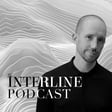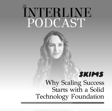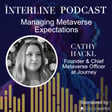Become a Creator today!Start creating today - Share your story with the world!
Start for free
00:00:00
00:00:01

Talking New, Blockchain-Backed Business Models With Arianee
Emma speaks with Pierre-Nicolas Hurstel, CEO and Co-Founder of Arianee, about enterprise-grade digital product passports, and the new digital infrastructure the company believes will be necessary for the business models of the future.
Transcript
00:00:03
Speaker
This capability and all the other capabilities of blockchain allowing the possibility to own the digital things, this is going to completely transform the way we use internet. Hello, everybody. Emma here, your host of the Interline Podcast.
Introduction: Pierre-Nicola Herstal and Ariane
00:00:22
Speaker
Today, I'm talking to Pierre-Nicola Herstal, the CEO and co-founder of Ariane.
00:00:28
Speaker
who are working on not only just enterprise-grade digital product passports, but also building what they believe is the new digital infrastructure that's going to be necessary for the business models of the future, from verifiable authenticity to entirely new systems of value, royalties, and data ownership.
00:00:45
Speaker
Pierre Nicola also joined our editor, Ben, on stage at Premiere Vision Paris earlier this year. So I wanted to build on that conversation, covering some of the same ground, but also getting into some new areas. You'll hear us talk about the steady progress of Web3, blockchain, NFTs and tokenization towards more mainstream adoption. We'll discuss the role of verifiable product identities in unlocking traceability for new products and in providing the foundations for true circularity.
00:01:13
Speaker
And we'll chat about why a new digital infrastructure will be a prerequisite for changing the web brands and consumers engage. Now, over to my interview with Pierre Nicola.
Career Journey and Founding of Ariane
00:01:24
Speaker
Good afternoon, Pierre Nicola. It's so wonderful to have you on the Interline podcast. Thank you very much for being here. We're so looking forward to talking with you. Hello. Thanks for having me.
00:01:35
Speaker
Can we begin by introducing yourself a little bit about your career to date and why you and your co-founders launched Ariane?
00:01:44
Speaker
Yes, sure. I've always worked close to the luxury and fashion industries. I started in consulting strategy and change, mainly working for major luxury groups. And I moved to New York in 2011 to run a trade show platform, fashion trade show platform with
00:02:10
Speaker
for trade shows at this time mainly focusing on Intimate and Swimwear and we launched one additional trade show focusing on the upstream of this industry.
00:02:26
Speaker
And then I created a conference in Los Angeles that was exploring the intersection of innovation, sustainability, and the fashion and luxury industry. So I started to really dig into the new challenges that fashion brands had to address. Omni-channel retailing, obviously.
00:02:53
Speaker
digital everywhere but also transparency traceability and control of the supply chain and at this moment one of my best friend was
00:03:08
Speaker
starting the INE project, he had asked me to be an advisor at the very beginning when he was just writing down the first concept and what we called white paper, which was a statement of what he
Vision: Connecting People with Blockchain
00:03:27
Speaker
wanted to do. And after a couple months of conversation, we decided to join forces.
00:03:33
Speaker
and build Ariane together. So we partnered, I took on the CEO role, he took on the chairman role, and we started like that with a vision that is embedded in the name, the Ariane link, the Ariane thread from the Greek mythology, and the idea that
00:03:58
Speaker
We would create a connection, a digital connection between people, the durable goods they own and the brands and stakeholders that would act from the conception creation of the good to the reparation.
00:04:21
Speaker
or service of this good and tomorrow to the transfer of this good to a new owner. And this Ariane thread, we build it with a new technology that's called the blockchain or web3 technology.
00:04:39
Speaker
that changes the paradigm in terms of who controls the data. This is a data that is controlled by users and brands without intermediary. And so we like to think that the mission, the vision has not changed even though after five years we explored a lot of territories.
00:05:03
Speaker
We want to allow users and brands to stay connected in a respected way, in a way that does not interfere with their, that does not leverage their personal data for commercial goods, for commercial purposes. And that allows them to keep the durable goods they own longer, protect their value and easily resell that.
00:05:31
Speaker
Right. What an important mission. And Ariane really has come so far in fashion and beyond in doing this. Now, before we get too deep, I think it's important to talk a little bit about what you already mentioned, a little bit about technology, but specifically now.
00:05:50
Speaker
about hyperizes and falls in fashion and how aligned that outward facing cycle is or isn't with real adoption. Because from the outside, there definitely have been spikes in interest and coverage of Wave 3 blockchain NFTs and token-based platforms
00:06:07
Speaker
And then periods where those words and concepts seem to fall out of favor.
Blockchain and NFTs: Transforming Ownership?
00:06:12
Speaker
How do you feel about those labels that I've just mentioned? And behind these public rises and falls, are we still steadily moving towards more mainstream adoption behind the scenes? The technologies we use are starting to become major. When we started in 2018, the main perception
00:06:37
Speaker
was that blockchain was a fantastic tool for finance and decentralization of finance and digital currencies. But outside of that, it was more perceived as a track and trace, upstream traceability tool. Then
00:06:58
Speaker
during the peak of the hype, brands and users and everyone in general discovered that it was possible to create assets that were not purely financial, attach these digital assets to art or membership. And all of a sudden, everyone thought that
00:07:22
Speaker
That was the next huge revenue generation thing, the next new community management thing. And this went a little bit too fast and too, I would say, yeah, it's kind of an exaggeration on the expectations and the possibilities.
00:07:46
Speaker
We've always used this technology for the same reason that I explained in the vision. And so at the very beginning, we were not even talking too much about NFTs. We were saying that we were using blockchain, but we were not talking too much about NFTs. And during the hype, obviously we
00:08:08
Speaker
raised our hand and be like, yeah, we, this is all made with the NFT standard today. It's probably less useful to, to mention that, but in the end, these, these three letters NFT it's, it's a very, very low, low layer of technology. It's a very simple standard that allows.
00:08:37
Speaker
an asset, a digital asset, which can be a content about a product, which can be the asset itself, a JPEG, a video, whatever, and to associate that with a proof of ownership and to allow someone to have control over this proof. And so this capability is going to completely transform
00:09:02
Speaker
This capability and all the other capabilities of blockchain allowing the possibility to own the digital things, this is going to completely transform the way we use internet, the way we use obviously financial tools, but also the way we control our personal data, the way we regain our digital sovereignty, the way we interact with services.
00:09:31
Speaker
It's just going to take time. The hype was vibrant but also exaggerated and now things are building and there's absolutely no doubt, you know, to quote Jan Roger's
00:09:49
Speaker
We are the guys telling you in 2004, 5, 10 that we will stream music and have access to everything in one click.
Tokenization: Transparency in Fashion Supply Chains
00:10:00
Speaker
It's kind of the same. We're the guys telling you that you will control and own your data. You will.
00:10:08
Speaker
not have to give away pieces of your life to access services. Value will be equally and easily shared over the internet, thanks to the simple thing that you can own a piece of digital data. And so all of that is happening. It's just a question of time. That makes sense. And that's a good analogy between sort of music
00:10:31
Speaker
and even movie streaming services for sure. So off to another three-letter acronym now from NFTs to DPPs, digital product passports. I'd like to talk a little bit about them and the supply chain transparency and chain of custody they need to be built on. Because I think that's the case right now in fashion is that people think of blockchain this way. Consumers want fashion to become less opaque
00:11:00
Speaker
when it becomes about the journey and the provenance of new products. And there's also a growing awareness that the most viable long-term model for fashion is circular. And I've seen statistics, I think, from one of your presentations that the secondhand market will make up 8% of the European more wider market in the next couple of years. Both of these things,
00:11:26
Speaker
seem to hinge on the same thing, full visibility, accountability, and item level identity that are valid for the extended lifespan of a product. Do you see tokenization as a way to achieve both of these things, transparency and circularity? Everyone has to understand that if we want to reach our goals in terms of
00:11:54
Speaker
price of temperature and inflection of the climate crisis, we should divide by three the amount of textile products that are created and sold in the world.
00:12:12
Speaker
So this is done by, you know, producing more better that we're going to reach that. This is too far. So I would say that for me, for us at INE, what really, really matters
00:12:31
Speaker
is the durability, the possibility to increase the lifespan of a good, the possibility to make the secondhand market like the existing stock of things so liquid and so easily accessible that you have good options secondhand that are
00:12:57
Speaker
that you can consider before considering firsthand and to create a way to make that valuable and to create business models on top of that. Because we're not saying that we should divide by three the number of brands or that we should, it's just that revenues should come from something else than just producing more goods.
00:13:21
Speaker
So that we can address with tokenization by giving a life to a product on the network, by creating a DPP that is more than just scanning a QR code and reading content, which is what the regulation will push for.
00:13:39
Speaker
by creating this digital asset that comes with the product, that travels with the owner, that evolves with the events of the life of the product, and that can be transferred to the next owner. And on top of this transfer, you can build, thanks to the composability of the blockchain, you can build
00:14:05
Speaker
services, you can build business models. This is where really there is a strong unique value that can be added by this technology. When you look at the upstream, the traceability and transparency, the fact that there's less opacity and you know what you're buying, I think it's very hard to guarantee
00:14:34
Speaker
what happens in the upstream. The way to do that would be to digitize completely all supply chain to make sure that every contributor in the supply chain, every layer of supplier
00:14:49
Speaker
provides and inputs the good information without any doubt on the trust that you can put on this player, which would require that people would not be in charge of inputting, which would require IoT everywhere.
00:15:08
Speaker
And so if you start thinking about that, if there are sensors on every single piece of raw material or scan that every single change of custody or step in the supply chain, and you push that already inside the fully digital system, that's 90% of the job. Putting that on the blockchain,
00:15:31
Speaker
would be fantastic. But if you don't have the two previous elements, sensors and IoT at every level and digitization, then the blockchain is useless. So that would require a huge work in the supply chain to make it super valuable. So I would say that blockchains are
00:15:51
Speaker
can have a much stronger impact in the fields of durability, circularity, data control in the way that they will empower users to enlarge the lifespan of their durable goods and empower brands to create value and business models around that. That's really where this can be game changer. That makes a lot of sense.
00:16:21
Speaker
Now, I want to draw a little bit more on this point, still talking about sustainability and circularity, and
Sustainable Growth: New Business Models in Fashion
00:16:28
Speaker
it's about actual mechanics of these two concepts. What do you feel that tokenization brings to the picture that a QR code linked to a consumer facing portal with a database on the background doesn't? So this is really about what distinguishes Ariane's approach on the philosophical as well as the technical level.
00:16:50
Speaker
read, write, own. These are the three phases of the internet. Read, you can just read content, write, you can contribute, own, you can own data. A QR code is just a link. So you put a QR code on something with a URL inside that leads you to a page on which you can read content about a product. So this is web one.
00:17:17
Speaker
This is what, you know, existed forever. This is what is the interaction with that you read. And then, and then what you know that the product has been made this or there that has been, okay, you have information on the product. It's great. Right. Can you contribute to that? What do you do with that? That would be web to own. You take a piece of that. You take this data and you control it in your phone. You can transfer it.
00:17:47
Speaker
You can add an economic incentive to it. You can make it interact with third parties, repair center, secondhand platforms, et cetera. That is what tokenization brings. The interoperability, the composability, the possibility to add financial incentives at the heart of the technology.
00:18:16
Speaker
That's a really key thing to understand for everybody listening, what you spoke about, about the web one, web two and web three. Thanks for bringing that up. I want to jump ahead briefly now to revisit a conversation that you started with our editor-in-chief, Ben Hansen, at Premier Vision Paris earlier this year, because I think it's important context for what we've spoken about so far. You've spoken about
00:18:45
Speaker
some of the industry's biggest stages about the disconnect between how fashion is really used, the value that consumers get out of buying a product, and how fashion brands make margin, which is almost exclusively from acquiring more new customers and selling new products. So that tension is really at the heart of waste and overproduction and efficiency,
00:19:10
Speaker
really all the things that are troubling the fashion industry. It's so endemic and it's really widespread. So can you help us understand just how big is that gap between the traditional model and a genuinely sustainable circular one? So we have an idea of how far the fashion industry actually needs to travel.
00:19:30
Speaker
I think the gap is huge. Again, to reach the goals and limit to degrees, the increase of temperature, we should divide by three the production of textiles.
00:19:49
Speaker
So then when you've said that, are we going to cut jobs, close companies? No. We have to be able to do that and to maintain growth and profitability.
00:20:05
Speaker
We have to be able to ensure that diversity exists, that creation thrives, that this cultural movement that fashion is can continue to expand. And we can't change everything at the same time. You can't
00:20:27
Speaker
change the course of the climate crisis and change the way the entire economy works at the same time. You can't say, let's divide by three. This is not, you know, this doesn't work. But at the same time, you can't just do nothing. And so the question is, where could revenues and margins come from if we were to produce less?
00:20:54
Speaker
And this very question is very, it's hard, you know, brands are, they are, they have know how they are, that they are artisans for some of them. They produce amazing goods created and their success is based on, you know, how many people want to buy them. What if that could change? What if business models could be created based on what happens after
00:21:25
Speaker
purchase? What if royalties could reward brands every time a product is resold? What if it was possible to grow without producing more? And so the gap is obviously huge, but we should be looking at that. And that's
00:21:49
Speaker
The regulation is always a little bit late. DPP is going to ask for content to push brands to disclose how they've produced and to push users to read that and make choices that are écléré, I would say in French, but that are mindful.
00:22:15
Speaker
But that's not enough. That's not enough. We need to push people and brands to buy and produce durable things, not to throw them away, to repair them and keep them longer, to incentivize that and we have to find a way to do that without breaking the economic engine. That's the big challenge.
00:22:36
Speaker
Exactly. We have to think about selling fewer products and really it's about fundamentally transforming the opportunities that brands have to engage with consumers. You touched on this a little bit about how things are changing, certainly from the brand perspective. How do you see it playing out how brands are going to interact with their consumers going forward?
00:23:01
Speaker
Well, I think a lot of it depends on how people can, how much longer they can stand to be the product, how much longer they, whether you talk about end users, but how much longer brands can support to spend sometimes the amount that they've placed in the production of a good.
00:23:29
Speaker
to spend the same thing to acquire a new customer. When you look at the tension and cost of acquisition in a very competitive
00:23:38
Speaker
fashion and beauty segments where you can spend up to 100%, 120%. The first basket just in cost of acquisition, we're talking 50, 80, 100, 120 bucks just to pay Facebook and Google for a completed purchase coming from social networks. So yes, it's good because it's
00:24:01
Speaker
heavily repeatable, it's easy to plan, but is it sustainable? Is it sustainable to be in a race for growth and new customers that ends up costing more just to acquire them than just to produce? So all of that and thanks to the capabilities of the blockchain, but also to
00:24:29
Speaker
the new threats that artificial intelligence will pose in terms of data control, access to data pools.
Blockchain: User Control vs Big Tech Monopolies
00:24:44
Speaker
I think the technological capabilities of the blockchain will make it inevitable that at some point people will regain control. They will regain control over their data.
00:24:59
Speaker
And...
00:25:00
Speaker
that will require new ways of doing things that will need to be easy and user-friendly, which is what's missing today a little bit because the first wave of innovation was mainly focused on building the infrastructure and the blockchain themselves. And so what's going to happen now is the emergence of protocols like the one we've developed and then on top
00:25:30
Speaker
applications. And when all of that will grow enough, it will be very easy just to control your data, to be in touch with whoever you want without any intermediary. And that's not surprising that the US are so reluctant to embrace crypto because they
00:25:53
Speaker
They know that the blockchain is the worst enemy of the big tech. It's the nightmare for them. It's the tool. It's the computer of ownership that is going to put back in the hands of users.
00:26:07
Speaker
their data, which is what they monetize, which is what makes them the monopolies that they are. So it's inevitable. Yes, it will be long and it will come through new apps and new interfaces. That's really something to think about and how things
00:26:31
Speaker
are inevitably going to change, especially over the next five to 10 years. I think that's a good place to wrap up. I want to ask one last question on something you touched on, which is infrastructure. Ariani has spoken about really building the standard of tomorrow, and we spoke about that now, how things are changing.
00:26:50
Speaker
What is your broad vision for fashion in terms of this technology?
Future: Blockchain Standards in Luxury Goods
00:26:55
Speaker
What does it mean to you to be building the data infrastructure that could underpin a lot of what the fashion industry and even more broadly wants to accomplish in the near and longer term future?
00:27:07
Speaker
Look, I think for luxury, it's going to become evident soon. It's becoming a standard for watches. It will be a standard for jewelry, for handbags, and for every strongly durable good. I think the fashion industry is a little bit different in terms of the structure. The companies are a little bit smaller. There's more fragmentation.
00:27:34
Speaker
So I think it's going to take a little bit longer for the fashion industry to actually grasp the opportunity. I think the fashion brands are going to first tackle the
00:27:44
Speaker
the purely compliance aspect and that only the most advanced and the most forward thinking of them will build right away on the most evolved stack of tech. So I think what we're going to see is that luxury is going to embrace that other durable goods industries are completely outside of this world are going to follow.
00:28:13
Speaker
and progressively fashion led by visionaries and forward-sinking brands will continue. Perfect. It has been enlightening to talk to you, Pierre Nicolas. Thank you so much for your time today. Your insights are really valuable and we can't wait to see what's next for Ariane and I guess the blockchain industry, but you're at the forefront, so we'll be watching. Thank you so much. I hope you enjoyed my conversation with Pierre Nicolas.
00:28:43
Speaker
Be sure to give Ariane a follow on their social media platforms, and you can also catch them at VivaTech Paris, which runs from the 22nd to the 25th of May. There is still much more to come on our upcoming podcast episodes, so make sure you don't miss an episode. Subscribe wherever you listen to podcasts. And as usual, also subscribe to our weekly newsletter, where we give you our analysis into the biggest stories of the week in fashion technology. I work on those weekly breakdowns with the rest of the team here.
00:29:13
Speaker
And we put a lot of thought each week into not only capturing the top headlines, but really analyzing them. You can access that newsletter on our website by clicking the newsletter icon at the top right corner of the screen. And it will be delivered straight to inbox every Friday. We also have our deep dive, free to download 2024 AI report coming soon. So keep an eye on the Interline for that. Thanks for listening. See you soon.


















